Your guide to home security systems: Full-service vs. DIY, must-have items, cost breakdowns
Nothing says “welcome home” like getting your front door kicked in and house burglarized. That’s exactly what happened to our family almost two years ago to the day.
It’s a bit ironic. I’ve been reviewing smart home security gadgets for more than a decade. But we didn’t have anything set up to protect our own house because we had only recently purchased it (our first home!) and hadn’t finished moving in. It was early July, peak summer break-in season, and even though we had a “don’t bother tenant” sign stuck on the front door to “trick” would-be bad guys, our mostly empty, just-bought house apparently stood out like a $100 bill in a penny jar.
The real cost of break-ins
Because we were mid-move, the robbers mainly got away with some construction tools. But the real hit was to our sense of security.
“In some ways, that’s even harder to deal with than the actual loss of ‘things’ for a lot of people,” says Rebecca Edwards, lead safety reporter for SafeWise, a site that studies crime and safety trends and reviews home security systems. “The emotional toll of a break-in is huge. When someone forces their way into your house, it’s a violation of the sanctuary you call home.”
Edwards also notes that break-ins happen every 30 seconds in America and the average loss is $2,661. Yet only 25% of Americans have any sort of home security system, and most people wait until after they’ve been robbed to get one. “When you lay it all out, it’s almost always worth the money to be proactive and invest in a security system.”
Summertime’s rise in crime
On average, burglaries rise about 10% between June and August, and this summer, that number could go even higher as more Americans catch up on vacations and time away after being cooped up by the pandemic.
“Most criminals are looking for the easiest way in when no one is home. Usually, that’s in the middle of the day, when everyone’s at work, or when you go on a vacation,” explains Fred Turra, an ADT custom home manager for the San Francisco Bay Area. “They’re looking for ease of access. It’s hot outside. Did someone leave a window or patio door open? Does that door have glass in it? Burglars are all about doing what’s easy, quick, and quiet. Most often here, I see a break-in right through the front door.”
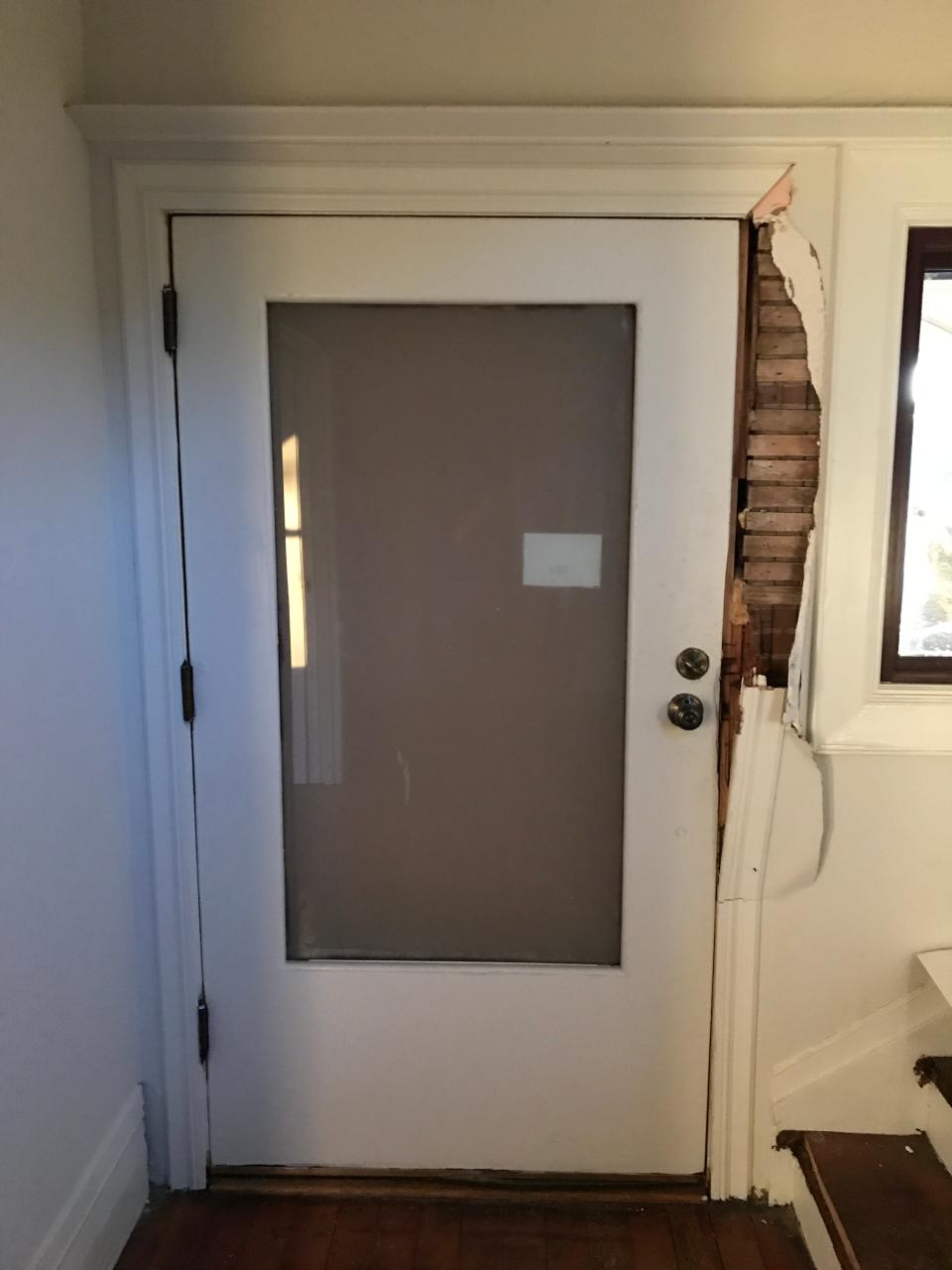
Turra is a former law enforcement officer who met with us in person shortly after our break-in, “There are all kinds of clues that no one’s home here right now,” he pointed out during a walk-through.
Missing front door aside, he told us, “Your curtains are open, there’s only one light on upstairs – and I bet it hasn’t changed at all – that it’s been on for the last several days, 24/7. There are no outdoor security cameras, no motion sensor lights on the sides of your house, no smart doorbell, and that large fence in front? That’s just hiding the burglars from the street."
He also asked whether we – or anyone else – had posted about the new home sale on social media, the same way we often post about vacations when we’re away. (Pretty sure the answer’s a hangdog, humbled “yes.”)
Turra walked us through myriad options for adding security to our new space. And that’s the good news here: There are more home security gadgets than ever before, in every price point and contract-commitment range.
The bad news? It can be really confusing to figure out what’s right for you. So let’s take a look at today’s high-tech do-it-yourself options, as well as more robust all-in systems – and try to keep that whole door-kicked-down thing from happening to you.
All-In
Spoiler alert – we chose ADT’s Command option – and two years in, it’s done well by us. That’s saying a lot considering we live in West Oakland, California, an urban area with some of the highest crime rates in the nation.
We also worked closely with Turra – who’s like that favorite uncle we now call for every security-related question and invite over for a barbecue – to layer in a robust, professionally installed, fully monitored smart security system. In other words, we’re not messing around anymore.
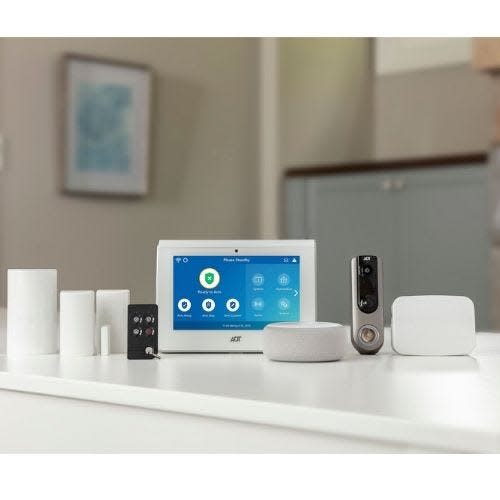
In addition to basics like reinforced locks and door jambs that make it much harder to break into the front door, Turra helped us with other layers of security including motion sensors on all the doors and windows as well as glass-break devices.
By the way, if you have pets, think hard about where to place motion sensors because they can be triggered by leaping cats, despite the alarm companies' claims that pets can't set them off. In addition to having a cat who likes to practice his high jump in the middle of the night, my editor had a beagle whose bark was apparently the same frequency as glass breaking. Or at least that's what the sensors thought.
"Then we moved into the more modern approach to it all with smart home devices," he recounts, ticking off a list of all the other measures we took.
"Doorbells you can answer from an app on your phone no matter where you are in the world, so it seems like you’re home even when you’re not. Indoor and outdoor security cameras, smoke and CO (carbon monoxide) detectors, flood sensors, lights you can turn on and off from an app, and a panic button with a safeword.”
How long will it take to set up?
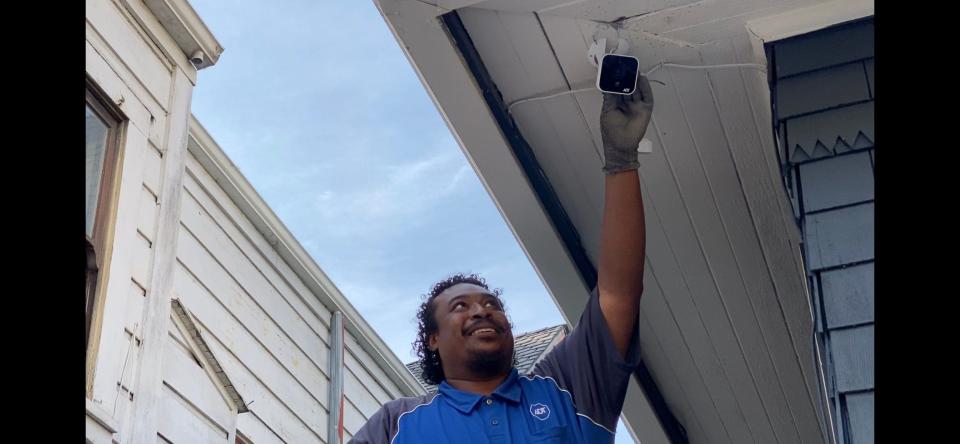
The home inspection to develop a plan took about twohours, then installation took an entire day. Someone has to be home during that time, for liability reasons, and to have a technician train you on how to use everything when it’s all ready to go.
We've had a pro come back twice to tweak a few sensors and adjust a lag between tapping the keypad and having those changes – mainly on our thermostat – register.
What does an all-in system cost?
By the time you add in bells and whistles as we did you can expect to pay anywhere from $600-$800 upfront for the equipment and installation plus around $46 a month for professional monitoring with a three-year contract, but there are less expensive packages and monthly plans.
ADT offers various promotions throughout the year, flexible payment options and a DIY package called Blue by ADT that runs around $20 a month for monitoring and lets you go month-to-month instead of getting locked into a yearslong contract.
When we first got it in 2019, I was underwhelmed by the equipment, especially the control panel and app, which felt antiquated. And we sometimes got as many as 10 calls per day from the monitoring center telling us to check on a window. (ADT fixed it soon afterward by replacing a glitchy sensor.)
Two years later, the app’s gotten better, too. According to an email the company sent for this article, ADT's hardware now works with more than 200 peripheral devices and supports voice control through Google Assistant and Alexa. The company says it's also continually deepening its systems' integration with 'Hey, Google' commands.
SafeWise’s Edwards says she has a "love-hate relationship with ADT. They really do offer something no one else does, and that’s experience, and name recognition – those alone deter a lot of would-be burglars.”
Edwards says her criticism mainly revolves around a lack of consistency and equipment availability between authorized retailers. “Your experience in Oakland might not be the same for someone else in Spokane, Washington, or Toledo, Ohio,” she adds.
She recommends reading the fine print and investigating all of SafeWise’s top-reviewed systems, including another top security pick, Vivint, along with a handful of DIY devices.
DIY devices
You can install your own security system – especially if you know your way around a hammer and an IP address and how to make all of the parts and pieces play nicely together under one roof.
For DIY options, my top picks include SimpliSafe, Abode and the 2nd generation Ring Alarm. USA TODAY sister site Reviewed.com has covered all of these extensively as well.
SimpliSafe
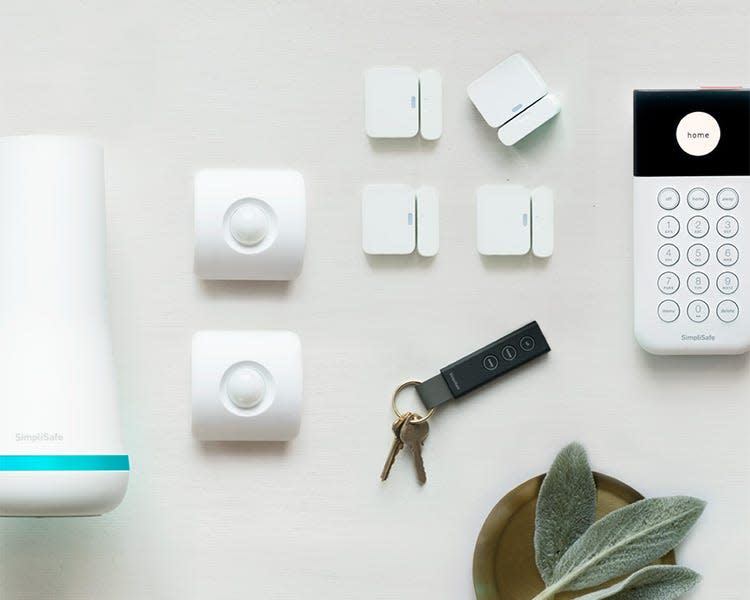
What's in the box and the bill? SimpliSafe’s wireless home security systems come with everything clearly labeled and are the easiest to set up in general. You can choose from several packages, which are on sale through Tuesday with prices as low as $181 for the Essentials package. That deal gets you a base station, monitor, keypad, three entry sensors, a motion detector sensor, and for the duration of the sale, a free HD camera.
You can also add professional 24/7 live monitoring for around $15/month and watch over it all from an app on your smartphone.
Pros: The base plugs into a standard electrical outlet and has a 24-hour backup battery. The entry sensors have a 10-year battery life, the others last 3-5 years and the keypad lasts the better part of a year. And it’s easy to peel off the backing and stick them exactly where you want. You can add up to 100 additional sensors, including an indoor video camera, a doorbell camera, smart lock and water leak detector.
Cons: The biggest drawback is that it doesn’t support robust outdoor security features like true weatherproof security cameras.
Abode
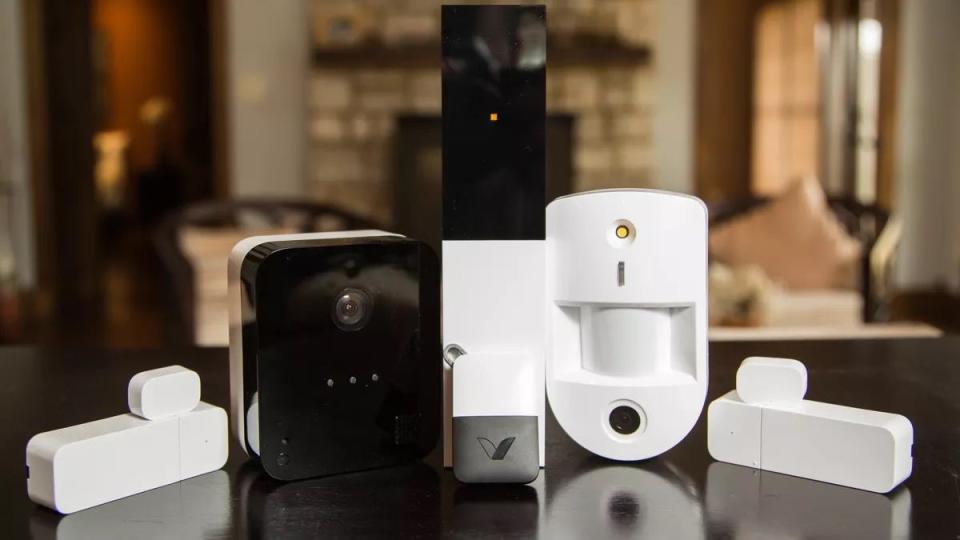
What's in the box and the bill? Abode provides all of the critical hardware we keep talking about – door, motion, and window sensors. Abode’s packages start at $232 for the Smart Security Set and include a gateway (or hub), motion sensor, window and door alarm and a key fob. Professional 24/7 monitoring runs about $20 per month with no long-term contract requirements.
Pros: Abode integrates with most other smart home devices, including Z-Wave and Zigbee-enabled gadgets, along with Amazon Alexa, Apple HomeKit, Google Assistant, and IFTTT (If This Then That). Like SimpliSafe, the hardware looks high-tech and blends well with a modern home, and you can monitor everything yourself with an app on your smartphone.
Cons: It does take a little more technical know-how to install and costs more than either SimpliSafe or the Ring system. And because of how much the additional sensors cost, it’s best for smaller homes and apartments.
Ring Alarm (2nd Gen)
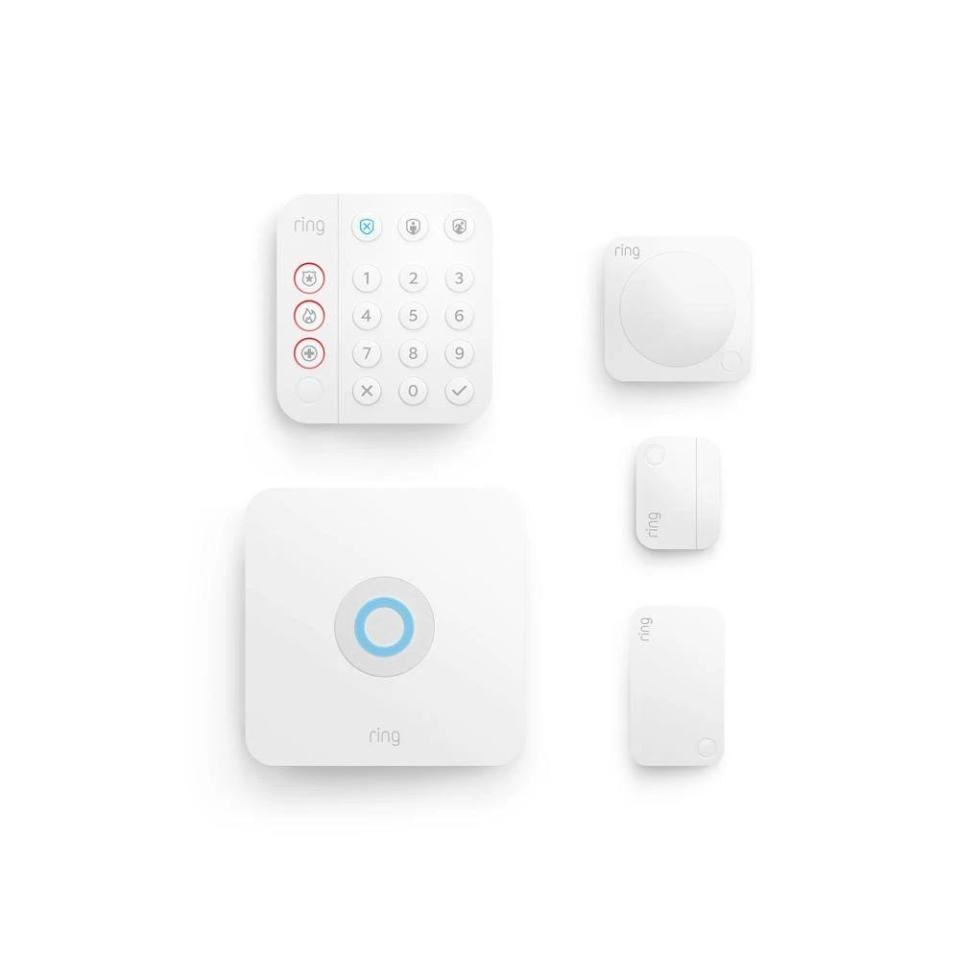
What's in the box and the bill? Ring doorbell alarms set the standard for guarding against porch pirates. System prices start at $200 for the 2nd-generation, five-Piece Alarm Security Kit, which gets you a base station, keypad, contact sensor, motion detector and range extender.
Pros: The five-piece setup is the best overall DIY budget pick here for protecting inside your space, too. If you're only looking at dollars spent, this is the way to go.
Cons: Like the other DIY picks, Ring is best for smaller places around 1,000 square feet. But it’s relatively bare-bones compared to the other picks. It also doesn’t have a dedicated glass-break sensor, and because it works only with Amazon Alexa, it doesn’t have as much smart-home support as the others here.
The bottom line
No single security system is perfect, and you’ll want to do some additional homework no matter what.
There are internet privacy and safety issues to consider, and anytime you have a live video feed of your private space, there’s a concern about who’s watching it.
Still, every option here is less expensive than the average cost of a break-in and can help alleviate many worries while you’re away. That’s worth a lot in the long run, too.
Jennifer Jolly is an Emmy Award-winning consumer tech columnist. Email her at jj@techish.com. Follow her on Twitter: @JenniferJolly. The views and opinions expressed in this column are the author’s and do not necessarily reflect those of USA TODAY.
This article originally appeared on USA TODAY: Home security system guide: What to know about ADT, SimpliSafe, more

